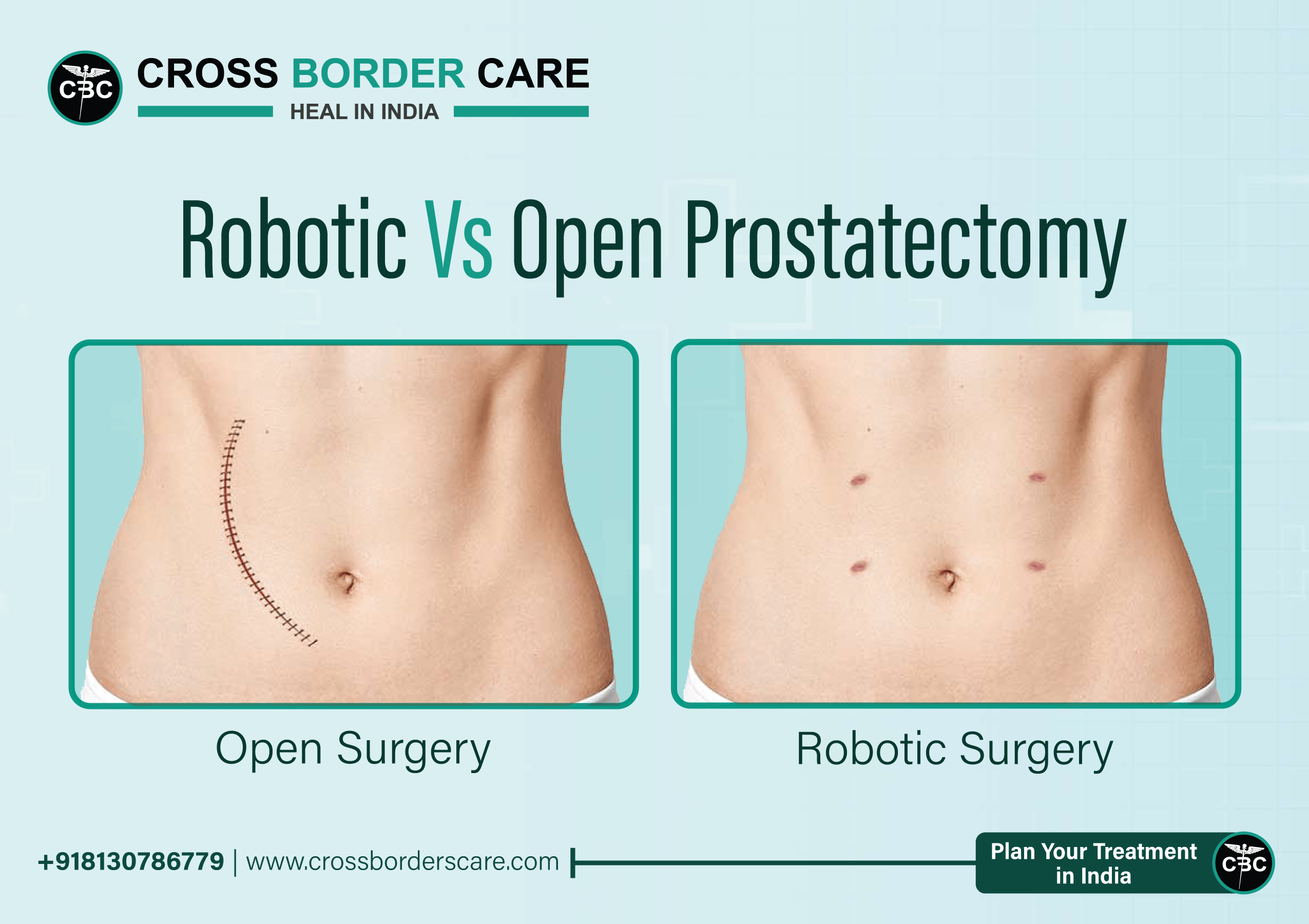Prostate Cancer is one of the most common diseases in men. However, with medical advancement, the treatment options for it have evolved too. The two most commonly used treatment options for prostate cancer are conventional prostatectomy and robotic prostatectomy. In this blog, let us do a detailed comparative analysis between Conventional VS Robotic Prostatectomy taking examples of real-time results and the impact of the outcome on different patients.
Conventional Prostatectomy:
Conventional Prostatectomy is also called open prostatectomy and has been in use for years to treat prostate cancer. In this procedure, the surgeon makes large incisions in the abdomen to remove the prostate gland. Although the surgery has a long-standing history, it has certain limitations:
- Recovery Time: Following conventional prostatectomy, patients typically require an extended hospital stay and a prolonged recovery period due to the invasive nature of the surgery.
- Blood loss: Open surgery can cause significant blood loss, requiring transfusions sometimes. The result can be complications and a longer recovery.
- Scarring: The large abdominal incision can leave a noticeable scar, which can be a cosmetic issue for some.
- Precision and dexterity: Traditional prostatectomy relies heavily on the surgeon’s manual dexterity. There can be a lot of challenges during the procedure, especially when dealing with intricate anatomical structures.
Robotic Prostatectomy:
It is a newly invented surgical technique that has gained a lot of popularity these days. It uses robotic arms which are operated by the surgeon and hence gives them the ability to perform the surgery with enhanced dexterity and precision. The advantages of robotic prostatectomy over conventional surgical procedures are as follows:
- Less Invasive: It is a less invasive surgical procedure in which the surgeon makes small incisions and hence there are fewer traumas to the surrounding tissues.
- Minimum Complications: Studies and real-time examples have shown that the risk of infection and other complications like erectile dysfunction, and urinary incontinence are less in robotic surgery as compared to conventional surgery.
- Enhanced Visualization: The robotic system provides better visualisation of the surgical site. It gives surgeons a better view of the prostate gland and the surrounding structures.
- Increased Dexterity: The robotic arms make it possible for the surgeon to manipulate with enhanced dexterity, facilitating precise movements during the procedure and enhanced dexterity.
Robotic Prostatectomy Vs Conventional Prostatectomy: Real-Time Results and Comparative Analysis
Many big hospitals and surgeons have compared the real-time outcomes of both types of surgeries. Here are the key outcomes that represent the difference between the two:
- Shorter hospital Stays: Patients who get prostate cancer surgery via robotic prostatectomy have to stay for fewer days in the hospital as compared to the people who undergo open surgery. The patients recover faster in robotic surgery, and they can return to their day-to-day activities soon.
- Less Blood Loss and Less Transfusion: The blood loss incurred by the patients is less in robotic prostatectomy and as a result, there is less need for blood transfusions. This decreases the risk of complications and hence the road to recovery is comparatively smoother.
- Surgical Margin: Study after study has demonstrated that robotic-assisted prostatectomy is more precise at removing cancerous tissue at the surgical margin as it preserves healthier tissue at the margin while allowing for more precise removal of cancerous tissue. Thus, this results in a better outcome for cancer control.
- Urinary incontinence and Erectile Dysfunction: In terms of bladder continence and erectile function, surgical procedures involving robotic-assisted technology have been shown to produce positive results in comparison to conventional procedures, when it comes to regaining urinary continence and erectile function postoperatively. The quality of life for prostate cancer survivors can be significantly affected by this.
- Pain and Discomfort: Patients who undergo robotic surgery experience less post-operative pain as compared to those who undergo conventional surgery. Since robotic surgery is a minimally invasive procedure, therefore, the road to recovery is pretty smooth.
- Cosmetically compliant: There is minimal or almost no scarring involved in robotic-assisted prostatectomy whereas in normal surgery a very big incision is involved. Such a big incision can greatly affect the cosmetic appearance and self-esteem of an individual.
- Precision: In robotic-assisted prostatectomy, the surgeon uses robotic hands to perform the procedure that gives them enhanced dexterity and control over delicate structures like blood vessels and nerves. With this level of precision, the functional outcomes are quite amazing and also the risk of complications is less.
- Learning Curve: Although both procedures require a high level of expertise and experience, robotic-assisted prostatectomy may require surgeons to undergo a steeper learning curve due to the automation of the procedure. There is no doubt that robotic surgery will eventually provide surgeons with a great deal of benefits as they gain proficiency.
- Cost: Considering the cost of robotic-assisted prostatectomy, it may be associated with a higher initial cost compared to conventional prostatectomy, as the investment in robotic technology is typically higher. There is, however, an important potential cost saving that can be realized over the long term as a result of improved patient outcomes, decreased hospital stays, and fewer complications during and after surgery.
- Preference of the patient: For some patients, the choice between conventional and robotic-assisted prostatectomy will also depend on the preference of the patient. There are some patients who may prefer robotic surgery over conventional surgery as a result of the potential benefits such as a shorter recovery time and improved functional outcome, while there are others who might prefer conventional surgery based on their specific medical conditions or a recommendation from their surgeon.
If you are facing any confusion about Conventional VS Robotic Prostatectomy which type of surgery to choose, please contact Cross Border Care right now at info@crossborderscare.com. We have a team of experts to assist you in making the most suitable decision for you and your health. Just fill out the form below, and our team will reach out to you in no time.
May 15, 2023


















